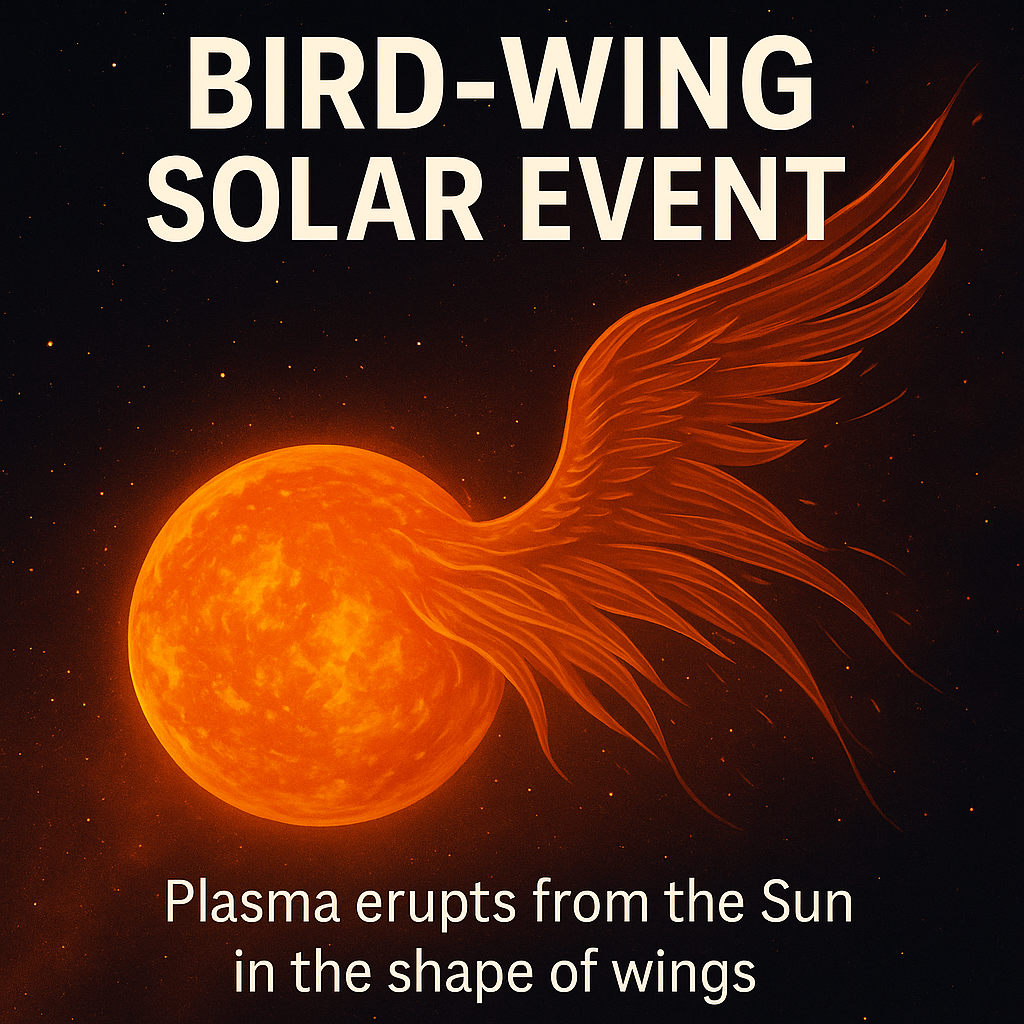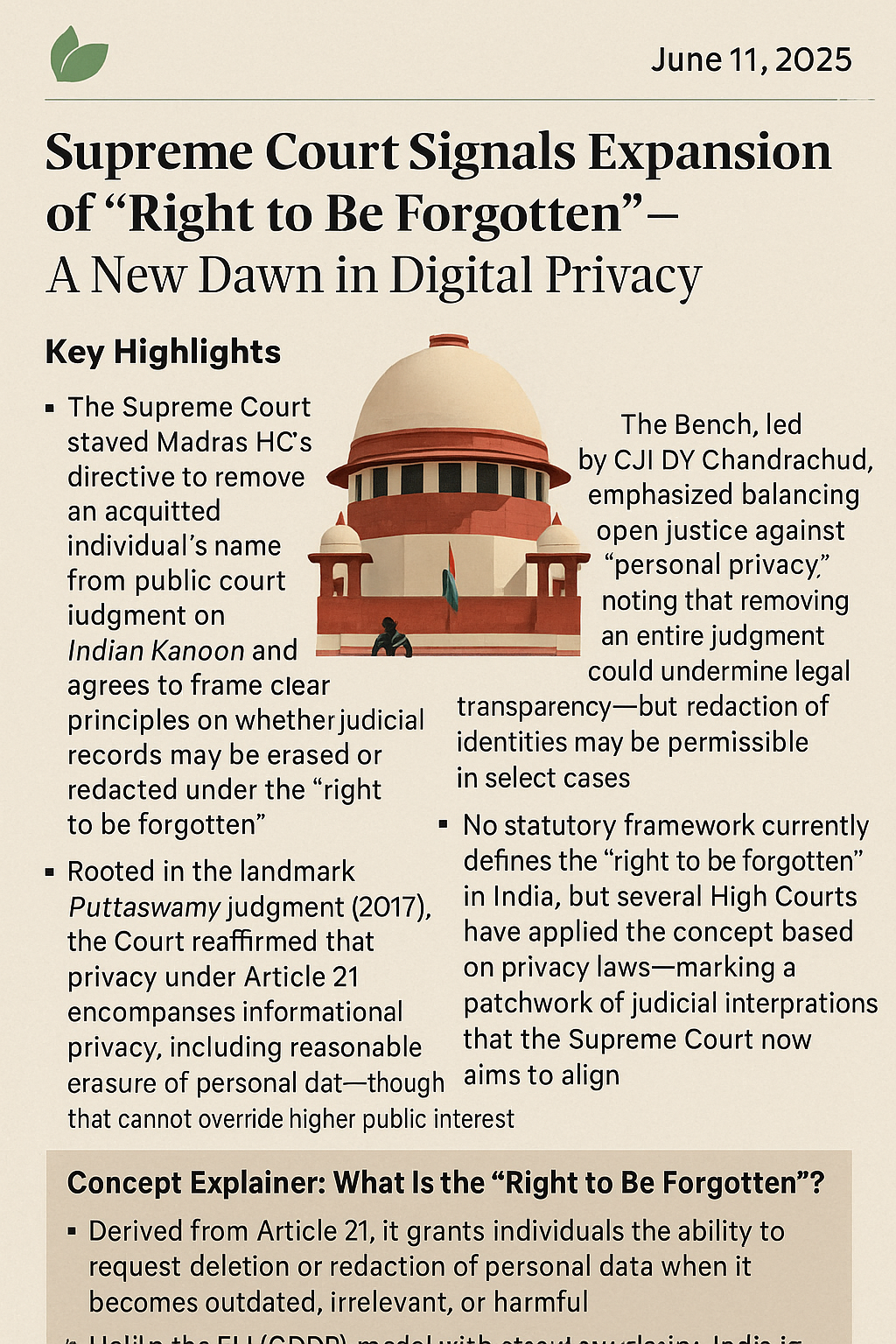
🧭May 22, 2025, Post 3: WHEN THE SUN SPREAD ITS WINGS: EARTH BRACES FOR SOLAR FALLOUT | High Quality Mains Essay | Prelims MCQs
WHEN THE SUN SPREAD ITS WINGS: EARTH BRACES FOR SOLAR FALLOUT

🌸 INTERNATIONAL
📅 Date: May 22, 2025
🧭 Thematic Focus: Science & Technology | Space Weather | Solar Phenomena
💬 Opening Whisper:
From the furnace of the cosmos, a wing of fire rose — not to destroy, but to remind us of our fragile place beneath the stars.
🔍 Key Highlights
- What is the Bird-Wing Event?
- A solar eruption observed by NASA satellites.
- Ejected plasma from the Sun’s northern hemisphere, shaped like wings.
- The plasma plume stretched over 1 million km, over twice the Earth–Moon distance.
- Flare + CME Combo
- The event involved both a solar flare and a coronal mass ejection (CME).
- Flares: Bursts of electromagnetic radiation due to magnetic reconnection.
- CMEs: Explosive clouds of charged particles that travel slower (1–3 days to reach Earth).
- Global Impact
- Caused radio blackouts across Asia, Africa, Europe, and the Americas.
- Risk of geomagnetic storms, affecting:
• Satellites
• Power grids
• GPS systems
• High-frequency radio links - Can also produce auroras visible at lower latitudes.
- Ongoing Monitoring
- Space weather agencies have issued high-alert advisories.
- Further assessments underway to gauge the technological and atmospheric effects.
🧠 Concept Explainer: Solar Flares vs. Coronal Mass Ejections
Both flares and CMEs stem from solar magnetic disturbances, but differ in speed and scope:
- Solar Flares:
• Electromagnetic bursts traveling at light speed.
• Immediate radio communication disruptions.
• Short-lived but intense. - Coronal Mass Ejections (CMEs):
• Massive plasma clouds launched into space.
• Travel at 250–3000 km/s, taking up to 72 hours to hit Earth.
• Can cause long-duration geomagnetic storms and global infrastructure damage.
Why It Matters:
These are the weather events of space — not atmospheric, but cosmic. Preparing for them protects satellites, astronauts, and critical systems on Earth.
🌍 Impact on Earth: From Beauty to Blackouts
The Bird-Wing event reminds us of the dual face of solar activity:
- On one side: Glorious auroras, dancing in unexpected skies.
- On the other: Silent failures in our unseen networks — power, communication, navigation.
Monitoring systems like NOAA’s SWPC and ISRO’s space weather division play a vital role in forecasting and mitigation.
📊 GS Paper Mapping
📘 GS Paper 3 – Science & Technology:
- Awareness in space phenomena
- Effects of solar weather on satellites and Earth systems
- Space-based monitoring systems
📘 GS Paper 1 – Geography:
- Geomagnetic storms and auroras
- Sun–Earth relationship
- Physical geography of space influences
🪔 A Thought Spark — by IAS Monk
“We build grids, codes, and constellations of steel — but it takes a single solar wing to dim the lights, mute the skies, and remind us: the sky is not a ceiling, but a living power.”
High Quality Mains Essay For Practice :
Word Limit 1000-1200
Solar Fury, Winged Beauty: Understanding the Bird-Wing Solar Event and Its Earthly Implications
Introduction
In the cosmic stillness of space, the Sun — our closest star — is anything but calm. It breathes, flares, bursts, and occasionally unleashes great wings of fire. One such recent event, dubbed the “Bird-Wing Solar Event”, was observed by NASA satellites erupting from the Sun’s northern hemisphere. A colossal wing-shaped plume of plasma, extending more than 1 million kilometres, has reignited global interest in space weather and its tangible impact on Earth.
This essay explores the scientific phenomena behind solar flares and coronal mass ejections (CMEs), the significance of the Bird-Wing event, and its far-reaching consequences for life on Earth. As we become increasingly reliant on space-based technologies, understanding solar activity is no longer a matter of curiosity — it is a necessity for survival and resilience in the modern world.
The Solar Canvas: A Dynamic Star in Motion
The Sun is a ball of hot, ionized gases, or plasma, governed by powerful magnetic fields. Unlike the stable light we receive daily, the Sun often undergoes cycles of heightened activity — collectively referred to as the Solar Cycle, which spans approximately 11 years.
During periods of maximum activity, the Sun produces solar flares, sunspots, and coronal mass ejections (CMEs). These are not mere surface phenomena — they are outbursts of electromagnetic and kinetic energy, capable of influencing the entire solar system.
The Bird-Wing Solar Event is a spectacular example of this activity. It featured two key elements:
- Solar Flare: A flash of electromagnetic radiation triggered by magnetic reconnection. These travel at the speed of light and can affect Earth within minutes.
- Coronal Mass Ejection (CME): A massive expulsion of plasma and magnetic field from the solar corona. These are slower, taking 1 to 3 days to reach Earth, depending on their velocity.
The Bird-Wing Event: A Solar Spectacle with Terrestrial Stakes
This particular event earned its poetic name from its visual form — plasma in the shape of wings, reminiscent of a bird mid-flight, extending gracefully into space. But beneath its celestial beauty lay tremendous energy.
NASA’s Solar Dynamics Observatory (SDO) and SOHO (Solar and Heliospheric Observatory) captured this event in high detail. The eruption stemmed from a magnetically active region on the Sun’s northern hemisphere. The CME that followed carried billions of tons of charged particles through space.
Early effects included radio blackouts across Asia, Africa, Europe, and the Americas, especially affecting aviation and maritime frequencies. As the CME approached Earth, global space agencies began issuing alerts for geomagnetic storms — the Earth’s magnetic field was about to be tested.
Understanding the Science: Solar Flares vs. CMEs
Though often grouped together, solar flares and CMEs differ fundamentally:
| Feature | Solar Flares | CMEs |
|---|---|---|
| Speed | Speed of light (instant impact) | 250 km/s to 3000 km/s |
| Nature | Electromagnetic radiation | Ejected solar plasma |
| Effects | Radio blackouts, satellite drag | Magnetic storms, GPS and power disruption |
| Duration | Short bursts (minutes) | Longer events (hours to days) |
These eruptions originate from magnetic reconnection — when magnetic field lines, stressed and twisted over time, snap and reconfigure, releasing energy explosively. Think of it as a cosmic rubber band snapping back into place after extreme twisting.
Impact on Earth: More Than Just Lights in the Sky
The Bird-Wing event raised alarms for several reasons:
- Geomagnetic Storms: As the CME collided with Earth’s magnetosphere, it caused fluctuations in the Earth’s magnetic field. These geomagnetic storms can induce electric currents in long conductors — from power lines to pipelines.
- Satellite Vulnerability: High-energy particles can damage satellite electronics, disrupt onboard systems, or increase atmospheric drag, causing orbit decay.
- GPS and Navigation Disruption: Solar events degrade precision navigation systems, affecting aviation, marine, and even military operations.
- Radio Blackouts: High-frequency (HF) communications, used by aircraft and emergency responders, can go silent during flare exposure.
- Auroral Displays: On a brighter note, auroras — the Northern and Southern Lights — intensify and expand, reaching latitudes where they are rarely seen. They’re the only visible reminder of these otherwise invisible solar battles.
Earth’s Magnetic Shield: The Unsung Guardian
Despite the Sun’s violent emissions, Earth remains relatively protected thanks to its magnetic field. The magnetosphere deflects most solar particles, allowing only a fraction to interact with the ionosphere and atmosphere.
However, strong CMEs like the one in the Bird-Wing event can compress the magnetosphere, causing magnetopause crossings and induced currents. In extreme cases, this can result in power outages — such as the famous Quebec blackout of 1989 caused by a geomagnetic storm.
Space Weather Monitoring: An Evolving Discipline
The Bird-Wing event highlighted the importance of space weather forecasting. Agencies such as:
- NOAA’s Space Weather Prediction Center (SWPC)
- NASA’s SDO and Parker Solar Probe
- ISRO’s Aditya-L1 solar observatory
…are instrumental in issuing alerts and helping governments and companies protect infrastructure.
Alerts range from radio blackouts (R-scale) to solar radiation storms (S-scale) and geomagnetic storms (G-scale). These warnings now influence decisions in aviation rerouting, satellite shielding, and power grid load management.
Looking Forward: Solar Cycles and Preparedness
The Sun is currently approaching Solar Cycle 25 peak, expected around 2025–26. More frequent and intense flares and CMEs are likely in the coming years.
Preparing for such solar activity involves:
- Hardening satellites and power grids with radiation shielding.
- Space weather curriculum integration in public infrastructure planning.
- International cooperation for early warnings and data sharing.
More broadly, space weather must be treated like terrestrial weather forecasting — with investment, innovation, and resilience planning.
Ethical and Societal Reflections: A Cosmic Reminder
The Bird-Wing event serves not just as a scientific alert but also as a philosophical metaphor. In an era when we believe we’ve tamed nature through code, AI, and power, one winged burst from a distant star reminds us of our cosmic vulnerability.
It is a call to humility and preparedness — and to deepen our sense of wonder for the unseen forces that govern our skies and lives.
Conclusion
The Bird-Wing Solar Event captured imaginations and sparked alerts. It was both a natural marvel and a technical threat — a reminder that even in our digitally dependent age, we are subject to the rhythms of celestial fire.
As Earth watches the skies more closely, we are learning to build both tools of resilience and poetry of understanding. In doing so, we do not just protect our satellites and systems — we begin to honor the quiet power that the Sun holds over all our orbits, seen and unseen.
Target IAS-26: Daily MCQs :
📌 Prelims Practice MCQs
Topic:
MCQ 1 – Type 1: How many of the above statements are correct?
Consider the following statements regarding solar flares and coronal mass ejections (CMEs):
1. Solar flares and CMEs are both caused by magnetic reconnection on the Sun.
2. Solar flares travel slower than CMEs and reach Earth in a few days.
3. CMEs are responsible for geomagnetic storms on Earth.
4. Solar flares can cause immediate radio blackouts on Earth.
How many of the above statements are correct?
A) Only two
B) Only three
C) All four
D) Only one
🌀 Didn’t get it? Click here (▸) for the Correct Answer & Explanation
✅ Correct Answer: B) Only three
🧠 Explanation:
Correct Answer: B) Only three
•1) ✅ True – Both phenomena are linked to magnetic reconnection.
•2) ❌ False – Flares travel at the speed of light, faster than CMEs.
•3) ✅ True – CMEs trigger geomagnetic storms by interacting with Earth’s magnetosphere.
•4) ✅ True – Flares cause sudden radio blackouts via electromagnetic radiation.
MCQ 2 – Type 2: Two-Statement Check
Consider the following two statements:
1. The Bird-Wing Solar Event involved both a solar flare and a coronal mass ejection (CME).
2. CMEs typically reach Earth instantly, causing sudden temperature changes in the upper atmosphere.
Which of the above statements is/are correct?
A) Only 1 is correct
B) Only 2 is correct
C) Both are correct
D) Neither is correct
🌀 Didn’t get it? Click here (▸) for the Correct Answer & Explanation
✅ Correct Answer: C) Both are correct
🧠 Explanation:
Correct Answer: A) Only 1 is correct
•1) ✅ True – The event involved both types of solar phenomena.
•2) ❌ False – CMEs take 1 to 3 days to reach Earth; they do not arrive instantly.
MCQ 3 – Type 3: Which of the above statements is/are correct?
Consider the following statements about the effects of solar events on Earth:
1. Geomagnetic storms can affect satellite operations and GPS navigation.
2. Auroras during such events are confined to polar regions only.
3. Power grids and radio communication networks can be disrupted by strong CMEs.
Select the correct answer using the code below:
A) 1 and 2 only
B) 2 and 3 only
C) 1 and 3 only
D) All of the above
🌀 Didn’t get it? Click here (▸) for the Correct Answer & Explanation
✅ Correct Answer: A) 2, 3, and 4 only
🧠 Explanation:
Correct Answer: C) 1 and 3 only
•1) ✅ True – CMEs interfere with satellites and navigation systems.
•2) ❌ False – Strong solar storms can cause auroras at lower latitudes.
•3) ✅ True – Induced currents can overload power grids and affect radio transmissions.
MCQ 4 – Type 4: Direct Factual
What was the approximate length of the plasma plume in the Bird-Wing Solar Event?
A) 384,000 km (distance from Earth to Moon)
B) 500,000 km
C) 1 million km
D) 3 million km
🌀 Didn’t get it? Click here (▸) for the Correct Answer & Explanation.
✅ Correct Answer: B) Adolf Goetzberger and Armin Zastrow
🧠 Explanation:
Correct Answer: C) 1 million km
•The solar eruption stretched over 1 million kilometres, more than twice the distance from Earth to the Moon.


















